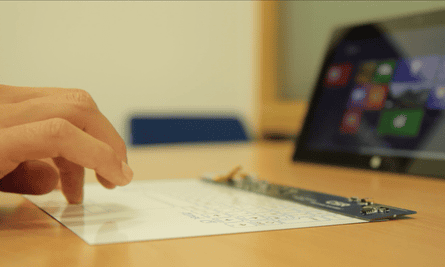In a packed noisy London coffee shop recently, I sat with Joe Johnston and Paul Williamson from Cambridge-based tech company and had a play with what has been dubbed the world’s thinnest touch surface.
Other reviews have focused on the impossibly thin touch responsive membrane with a printed outline of a keyboard. It is true that the first thing you do is pick it up, hold it and flex it. Watching others engage with the keyboard for the first time, their first word is usually “wow”.
But honestly, that isn’t the ‘wow’. The thin keyboard isn’t what piques my interest. It feels like an idea that is only 60% formed and missing the critical pieces to make me want one.
What is really interesting is actually the combination of the CIT touch membrane, the Atmel microcontroller interpreting the map of the membrane and the CSR Bluetooth(c) Smart chip.

CSR, and fellow Cambridge tech firm CIT, both innovate in the space behind the businesses like Nike and Bose. They develop the technologies to connect us to our future devices and them to each other.
Johnston and Williamson are not trying to suggest their keyboard is market ready, and one minute of playing with it proves that. But it’s the underlying technology that is market ready. CSR have proved convincingly that three independent business-to-business companies can quickly combine their innovations – and it works.
The possibilities for small businesses to innovate in a space, especially when deploying common comunication technologies like Bluetooth Smart, mean they can suddenly punch far above their weight in the tech world.
Do you have an idea for a consumer device? Would you like to link it to a smartphone? There is no longer a requirement to limit the connectivity of a device to just one OS platform or handset manufacturer.
Common communication chips now mean companies can pitch a hardware offering via crowdfunding and by building an app for the various platforms. It means ideas now have real, scalable potential.
Common communication technologies for hardware may well do for smartphones what apps did four years ago.
So what’s my ‘wow’? Low energy, wireless communication. Common language protocols. Flexible responsive touch surfaces. Tiny, fast micro-controllers providing SoC processing. Everything that is in the keyboard but not actually the keyboard itself.
There are many who have forecast devices using low power, flexible screens with physical touch input. This is another small but important step in that direction.
And maybe, one day, we will be able to read the Guardian on a thin, light, flexible screen – and most importantly, complete the crossword by hand.
Comments (…)
Sign in or create your Guardian account to join the discussion